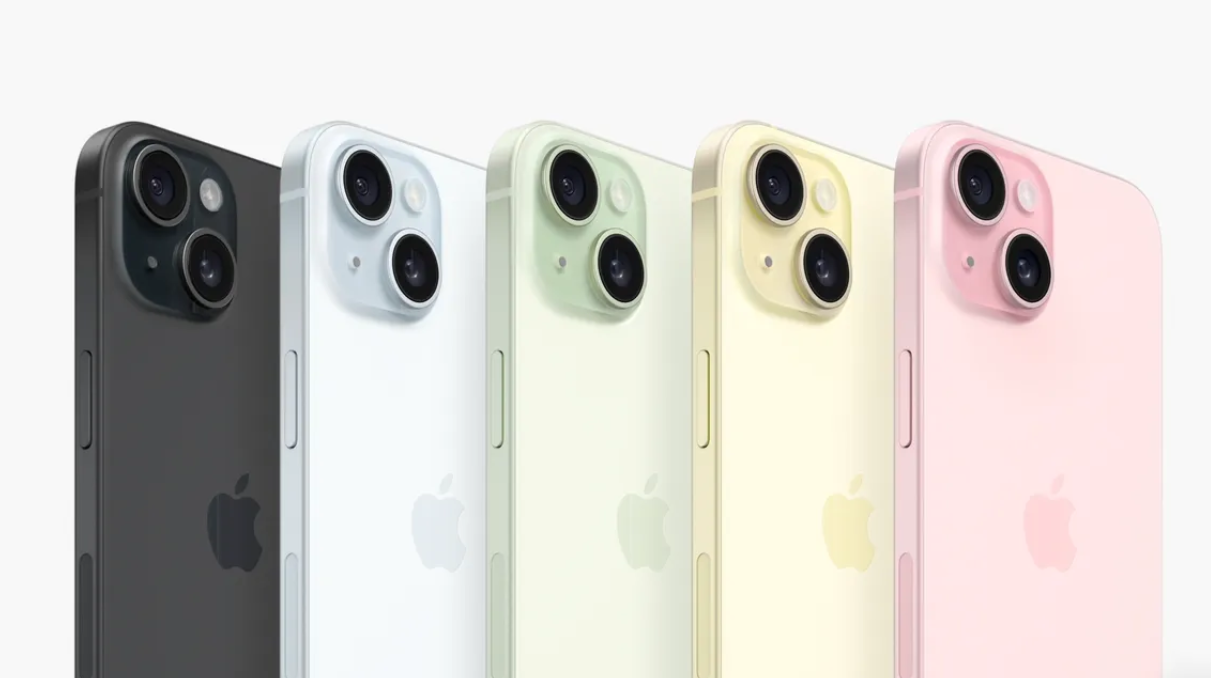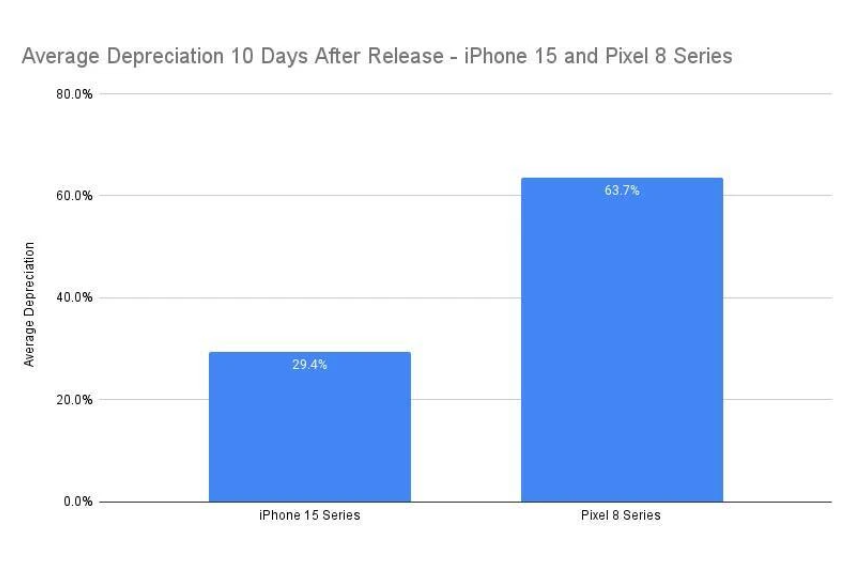Highlights
- Pixel 8 experiences a significant 63.7% drop in resale value within the first ten days post-launch.
- iPhone 15 exhibits a slower depreciation rate, losing 28.8% of its value since its release.
- iPhone 13 outperforms both recent models with the best value retention a month post-release.
In the dynamic smartphone market, the inevitability of depreciation hits hard and fast post-launch.
Recent insights from SellCell, which consolidates data from multiple buyback vendors, reveal a stark contrast in the value retention trajectories of the latest industry titans – the Google Pixel 8 and the Apple iPhone 15.
Apple’s Slow and Steady Value Decline
The iPhone 15, adhering to Apple’s legacy, showcases a slower depreciation curve. It has seen its worth decline by 28.8% since its debut.

This translates into an average $338 dip in value – a notable drop but one that’s less severe than its predecessor, the iPhone 14, at the same post-launch period.
Interestingly, the iPhone 13 still reigns as the champion of value retention among its kin, shedding just 18.7% a month after its introduction.
Google’s Steeper Slide
Conversely, the Pixel 8 has experienced a precipitous fall in market value.
Within a mere ten days following its release, the device saw an astonishing 63.7% plunge in resale value – a rate that more than doubles the depreciation percentage of the iPhone 15.
This stark contrast highlights the variance in post-purchase value sustainability between the two flagship devices.
Longevity Beyond Value

Despite the rapid devaluation, both the iPhone 15 and Pixel 8 stand as pillars of technological innovation, promising extensive support in the years ahead.
For consumers planning to extend their device’s lifecycle for a few years, the initial depreciation might seem less concerning.
Nonetheless, the immediate loss in value can be disconcerting for any tech enthusiast or investor.
GOOGLE PIXEL 8 KEY SPECIFICATIONS
Key Specs
| RAM | 8 GB |
| Processor | Google Tensor G2 |
| Rear Camera | 64 MP + 48 MP + 12 MP |
| Front Camera | 16 MP |
| Battery | 5000 mAh |
| Display | 5.8 inches (14.73 cm) |
General
| Launch Date | May 10, 2023 (Unofficial) |
| Operating System | Android v12 |
Performance
| Chipset | Google Tensor G2 |
| CPU | Octa core (2.85 GHz, Dual core, Cortex X1 + 2.35 GHz, Dual core, Cortex A78 + 1.8 GHz, Quad core, Cortex A55) |
| Architecture | 64 bit |
| Fabrication | 4 nm |
| Graphics | Mali-G710 MC10 |
| RAM | 8 GB |
Display
| Display Type | Super AMOLED |
| Screen Size | 5.8 inches (14.73 cm) |
| Resolution | 1080 x 2268 pixels |
| Pixel Density | 433 ppi |
| Screen to Body Ratio (calculated) | 79.46 % |
| Bezel-less display | Yes with punch-hole display |
| Touch Screen | Yes, Capacitive Touchscreen, Multi-touch |
Design
| Height | 150.5 mm Compare Size |
| Width | 70.8 mm |
| Thickness | 8.9 mm |
Camera
| MAIN CAMERA | ||
| Camera Setup | Triple | |
| Resolution | 64 MP f/1.9, Wide Angle, Primary Camera 48 MP f/3.5, Telephoto Camera 12 MP f/2.2, Ultra-Wide Angle Camera |
|
| Autofocus | Yes | |
| Flash | Yes, LED Flash | |
| Image Resolution | 9000 x 7000 Pixels | |
| Settings | Exposure compensation, ISO control | |
| Shooting Modes | Continuous Shooting High Dynamic Range mode (HDR) |
|
| Camera Features | Digital Zoom Auto Flash Face detection Touch to focus |
|
| Video Recording | 1920×1080 @ 30 fps | |
| FRONT CAMERA | ||
| Camera Setup | Single | |
| Resolution | 16 MP f/2.2, Ultra-Wide Angle, Primary Camera | |
| Video Recording | 1920×1080 @ 30 fps | |
Battery
| Capacity | 5000 mAh |
| Type | Li-Polymer |
| Removable | No |
| Quick Charging | Yes, Fast |
| USB Type-C | Yes |
Storage
| Internal Memory | 128 GB |
| Expandable Memory | No |
Network & Connectivity
| SIM Slot(s) | Dual SIM, GSM+GSM |
| SIM Size | SIM1: Nano, SIM2: eSIM |
| Network Support | 5G Not Supported in India, 4G Supported in India, 3G, 2G |
| VoLTE | Yes |
| SIM 1 |
4G Bands:
TD-LTE 2300(band 40)
FD-LTE 1800(band 3) 3G Bands:
UMTS 1900 / 2100 / 850 / 900 MHz
2G Bands:
GSM 1800 / 1900 / 850 / 900 MHz
GPRS:
Available
EDGE:
Available
|
| SIM 2 |
4G Bands:
TD-LTE 2300(band 40)
FD-LTE 1800(band 3) 3G Bands:
UMTS 1900 / 2100 / 850 / 900 MHz
2G Bands:
GSM 1800 / 1900 / 850 / 900 MHz
GPRS:
Available
EDGE:
Available
|
| Wi-Fi | Yes, Wi-Fi 4 (802.11 b/g/n) |
| Wi-Fi Features | Mobile Hotspot |
| Bluetooth | Yes, v5.2 |
| GPS | Yes with A-GPS, Glonass |
| USB Connectivity | Mass storage device, USB charging |
Multimedia
| Loudspeaker | Yes |
| Audio Jack | USB Type-C |
Sensors
| Fingerprint Sensor | Yes |
| Fingerprint Sensor Position | On-screen |
| Other Sensors | Light sensor, Proximity sensor, Accelerometer, Compass, Gyroscope |
FAQs
How does the Pixel 8’s value retention compare to the iPhone 15’s?
The Pixel 8’s value retention is notably lower than that of the iPhone 15. Within just ten days after its release, the Pixel 8 saw a sharp 63.7% decrease in resale value, while the iPhone 15’s value went down by 28.8% since its launch.
Why is the Pixel 8 depreciating so rapidly compared to the iPhone 15?
Market trends historically show that Apple products maintain their value longer than Android devices. The rapid depreciation of the Pixel 8 could be due to several factors, including market perception, demand, and brand loyalty associated with Apple’s products.
How does the iPhone 13 compare with the iPhone 15 in terms of value retention?
The iPhone 13 has shown superior value retention compared to the iPhone 15. A month after its release, the iPhone 13 had depreciated by only 18.7%, suggesting that not all new models follow the same depreciation pattern.
What should consumers keep in mind about the depreciation rates of smartphones?
Consumers should be aware that all smartphones depreciate over time, but the rate can vary significantly between models and brands. While depreciation is a factor to consider, it’s also important to focus on the phone’s features, support lifespan, and how well it meets individual needs.
